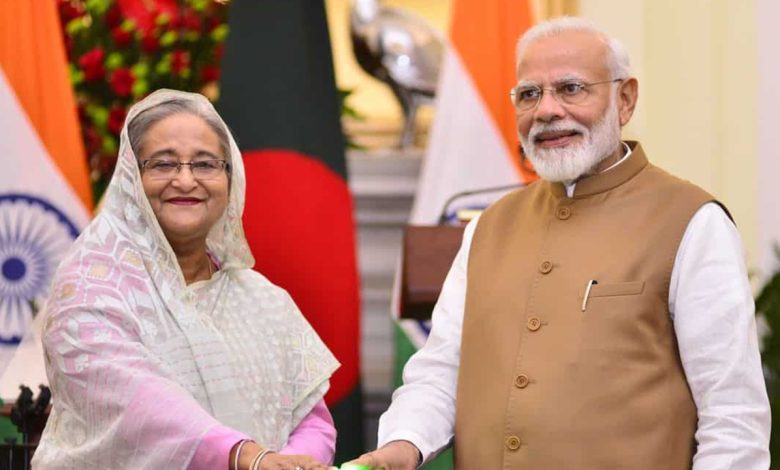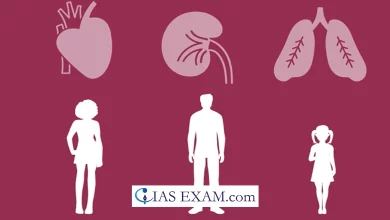Daily Current Affairs for UPSC
India Bangladesh Relation
Syllabus- International Relation [GS Paper-2]

Context- On March 18, the first cross-border oil pipeline that will transport diesel to Bangladesh will be opened by the Indian prime minister and the prime minister of Bangladesh.
Key Highlights
- According to the report, officials from the Bangladesh Petroleum Corporation were quoted as saying that Delhi would use the 130-kilometer India-Bangladesh Friendship Pipeline (IBFP), which was constructed with approximately Rs 3.46 billion drawn from the Indian Line of Credit (LoC), to export diesel to Dhaka.
- In 2017, a long-term agreement was signed to bring diesel from India to Bangladesh via the pipeline, which runs from Siliguri, West Bengal, to a Meghna petroleum depot in Parbatipur, Dinajpur.
- The two-sided project sent off in Walk 2020 had an underlying cutoff time of June 2022 that was pushed back one more year because of complexities from the Coronavirus pandemic, the report added.
- The pipeline runs 125 kilometers inside Bangladesh and 5 kilometers inside India. In the past, Bangladesh imported diesel from India via railway carriages.
- The two premiers likewise joined the notable function for the IBFPL in September 2018 through video conferencing, the report said.
- India also dropped its objection to Dhaka building anywhere within 150 yards of the zero lines of Bangladeshi territory.
Areas of cooperation between India and Bangladesh
-
- Following Bangladesh’s independence, amiable relations between India and Bangladesh emerged.
- The humanitarian, moral, diplomatic, and military assistance provided by India was crucial to Bangladesh’s liberation. “Friendship with India is a cornerstone of Bangladesh foreign policy,” Bang Bandhu (Sheikh Mujeeb ur Rehman) had explicitly acknowledged.
- Security and Border Control
-
-
- The two nations have entered into a number of security cooperation agreements.
- These include a 2011 agreement on a coordinated Border Management plan to effectively control cross-border illegal activities and crimes by coordinating the efforts of both border guards.
- Following the exchange of ratification documents during the Hon’ble Prime Minister’s visit to Bangladesh in June 2015, the Land Boundary Agreement (LBA) between India and Bangladesh entered into force.
- Strip maps were signed and the Indian and Bangladeshi enclaves in each other’s countries were exchanged as part of this agreement.
- The understanding will assist with bettering the executives and controlling the issue of dealing, unlawful development, and so on.
- According to the award made by UNCLOS on July 7, 2014, the settlement of the maritime boundary arbitration between India and Bangladesh paved the way for the economic development of this region of the Bay of Bengal and will be beneficial to both nations.
- An annual Coordinated Patrol (CORPAT) between the two Navies was established by India and Bangladesh. From June 24 to June 29, 2018, the inaugural edition was released. It is a significant step toward enhancing the operational ties that exist between the two Navies.
- River Water Sharing
- India and Bangladesh share 54 rivers, with Bangladesh being the lower riparian nation.
- As a lower riparian country, Bangladesh stays in danger from the effects of streams from India.
- However, India does provide Bangladesh with flood forecasting assistance by sharing seasonal data on water flow and rainfall.
- Since November 1972, a bilateral Joint Rivers Commission (JRC) has been in place to maintain communication between the two nations and maximize the benefits of their shared river systems.
- The Ganges Waters Treaty, which was signed in 1996 to share Ganges River waters during the dry season, has also worked well.
-
- Bilateral Trade
-
-
- Trade between India and Bangladesh has increased steadily over the past few years thanks to the Bangladesh river.
- The relationship’s current dynamics are very positive. Between 2017 and 2018, trade between India and Bangladesh amounted to approximately $ 9.3 billion, more than three times the value of $ 2.67 billion a decade ago.
- Under the “Blue Economy” program, which entails the synergized efforts of littoral states in the exploration of hydrocarbons, marine resources, deep-sea fishing, preservation of marine ecology, and disaster management, India and Bangladesh are looking to strengthen economic cooperation through joint investments and cooperation.
-
- Exchange and Obligation Concessions
-
-
- India’s commodities to Bangladesh in 2017-18 were around US $ 8.4 billion, and imports from Bangladesh during a similar period were around US $ 900 million.
- Under SAFTA, SAPTA, and APTA, substantial duty concessions have been granted to Bangladesh.
- Bangladesh and other SAARC LDCs have had quota-free, duty-free access to India on all tariff lines since 2011, with the exception of tobacco and alcohol, which are on the sensitive list under SAFTA.
- For the benefit of communities along the border, four Border Haats have been established—two in Tripura and two in Meghalaya.
- The total amount of Indian investments in Bangladesh is $3.11 billion, and this number is rising. Between 2015 and 2016, Indian FDI in Bangladesh amounted to $88.0 million.
- During Bangladesh PM’s visit to Bangladesh in April 2017, the Indian private sector signed agreements that will bring in more than $9 billion in foreign investment.
- India’s Economic Assistance to Bangladesh
- During his visit to Bangladesh in June 2015, India announced a new $2 billion Line of Credit. This Credit extension will cover projects in the space of Streets, Rail lines, Power, Transportation, SEZs, Wellbeing and Clinical Consideration, and Specialized Training.
- Bangladesh received a $5 billion credit from India in April 2017, of which $4.5 billion will be used to implement a developmental project and $500 million will be used by Dhaka to purchase defense equipment from New Delhi.
- Bangladesh receives grant support from the Indian government for projects under the “Aid to Bangladesh” program in addition to LOC funds.
- Projects like building schools and colleges, laboratories, dispensaries, deep tube wells, community centers, and renovating historical landmarks and buildings, among others have received funding from the Indian government as part of this program.
- In the towns of Rajshahi, Khulna, and Sylhet, three Sustainable Development Projects (SDPs) are currently in progress.
- One of the hallmarks of India-Bangladesh relations is cooperation in the power and energy sectors.
- A deal was made by India, Russia, and Bangladesh to build the Rooppur atomic plant in Bangladesh. In addition, India has been training Bangladeshi nuclear scientists for the project and providing support for capacity building.
- Both the export of power from Tripura to Comilla and the export of Internet bandwidth from Bangladesh to Tripura were officially launched by the two Prime Ministers in March of 2016.
- At Rampal, a 50:50 joint venture between India’s National Thermal Power Corporation (NTPC) and Bangladesh Power Development Board (BPDB) is developing the 1320 MW coal-fired Maitree thermal power plant.
- In the oil and gas sector of Bangladesh, numerous Indian public sector entities, including the Indian Oil Corporation, Numaligarh Refinery Limited, Gas Authority of India Limited, and Petronet LNG Ltd, collaborate with their Bangladeshi counterparts.
- In a 50-50 partnership with Oil India Limited, ONGC Videsh Ltd. has acquired two shallow water blocks in Bangladesh and is currently conducting exploration in these blocks.
- Connectivity All modes of transportation connect India and Bangladesh. Along the border, 36 operational Land Customs Stations (LCSs) and 2 Integrated Check Posts (ICPs) facilitate the road transportation of goods.
- Since the Petrapole-Benapole ICP accounts for approximately half of the bilateral trade, it has been decided to operate these land ports 24 hours a day, 7 days a week since August 2017.
- Since its inception in 1972, the Protocol on Inland Water Trade and Transit (PIWTT) has been in effect. It allows goods to move through Bangladesh’s river systems on eight distinct routes by barges or vessels.
- India and Bangladesh place a high priority on connecting through the Coastal Waterways made possible by the signing of the Coastal Shipping Agreement. It has empowered direct ocean development of containerized/mass/dry freight between the two nations.
- The passenger train service “Maitree Express” that connects Kolkata and Dhaka now operates four days a week and is a fully air-conditioned train.
- Dhaka and Chittagong are connected to New Delhi, Kolkata, and Mumbai by frequent flights from India.
- The Motor Vehicles Agreement (MVA) between Bangladesh, Bhutan, India, and Nepal (BBIN) will significantly improve road connectivity.
- In August 2016, a trial run of truck-based cargo transportation from Kolkata to Agartala via Dhaka and New Delhi via Kolkata and Lucknow via Dhaka was carried out.
- Technical Cooperation
- Bangladesh is a significant ITEC partner nation, and numerous Bangladeshi participants have enrolled in ITEC-sponsored training courses.
- Moreover, various instructional classes are in progress for intrigued Bangladeshi authorities/nationals including staff of organization, police, line watching powers, military, opiate control officials, educators, and so on.
-
- Cultural Exchange
-
- For the past 43 years, the Bengali literary monthly magazine “Bharat Bichitra” has been published in print and online by the High Commission of India. The magazine is viewed as truly outstanding of its sort in Bangladesh and has a wide readership among all segments of society.
- Yoga, Hindi, Hindustani Classical Music, Manipuri Dance, Kathak, and Painting are some of the regularly offered training courses at the Indira Gandhi Cultural Centre. Students from Bangladesh enjoy the courses.





.png)



